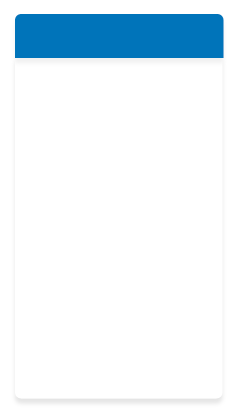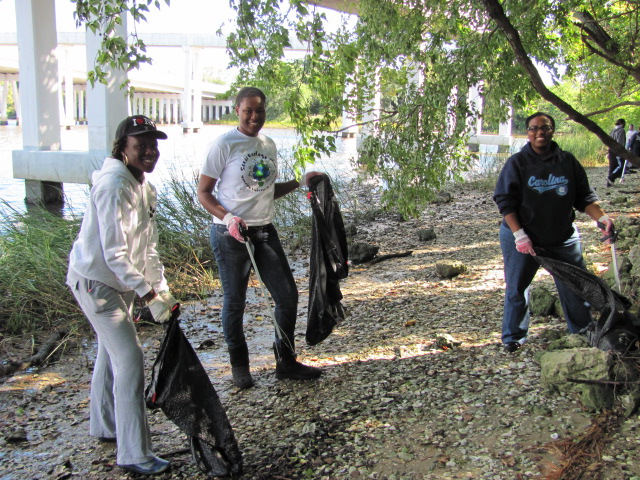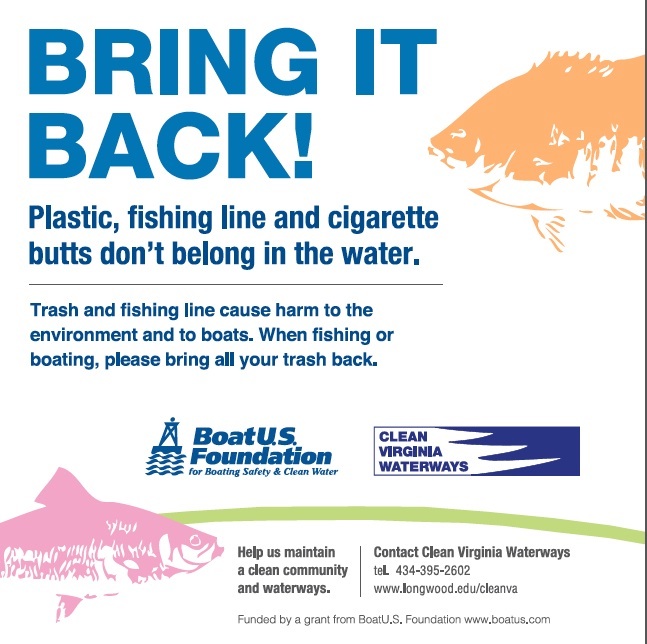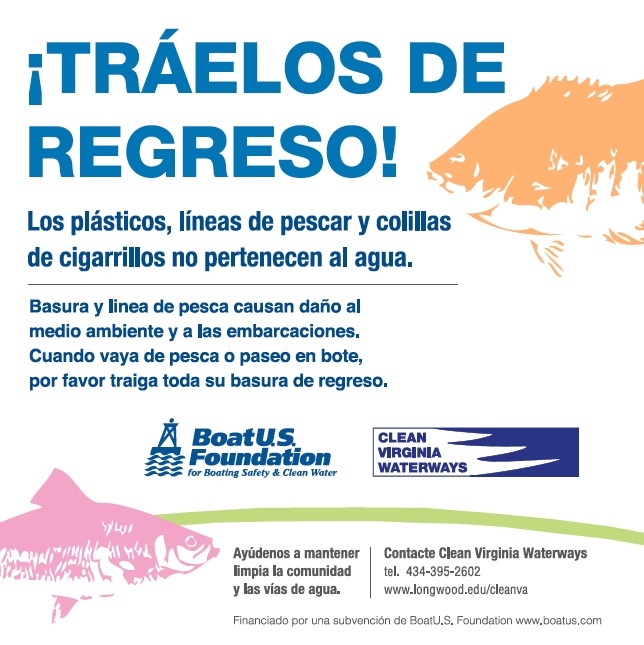How Are The Data Used?
Collecting data from the volunteers is just part of the process. The next step is to use the data to combat sources of litter. Clean Virginia Waterways does this in several ways:
Sharing the data
Virginia's aquatic litter data are shared with many interested organizations and groups, including the U.S. Coast Guard. The USCG is responsible for enforcing the international protocol known as MARPOL (The International Convention for the Prevention of Pollution from Ships is commonly referred to as MARPOL [Marine Pollution]). MARPOL prohibits dumping at sea. Data such as ours help the Coast Guard analyze how well the boating community is upholding the MARPOL agreement by not throwing their solid waste into the oceans. One USCG program "Sea Partners," (which educates boaters on the laws concerning handling solid waste at sea) reviews our data, and focuses its efforts in areas where more education is needed. The National Park Service also has used our data to identify areas in their Virginia parks that require special efforts. For example, our volunteers located a tributary to the Potomac River that had been a dumping area for tires for years. Since this was in a National Park Service park, we worked with them to get the volunteers, equipment and trucks needed to remove the tires. So far, two tire-removing events have been held there. The NPS also worked with local law enforcement officials in northern Virginia to ticket people who littered a popular fishing area on the Potomac River. Our data was part of the evidence used to justify the ticketing. Data are also shared with anyone interested. Site Captains and reporters often call to learn the major litter problems in their area.
After volunteers in Virginia fill out the data cards, they are collected by Site Captains, and sent to Clean Virginia Waterways. CVW looks them over for the "big picture," then we organize them by county, bundle them up and send them to The Ocean Conservancy. The Ocean Conservancy's staff enters all the data into a computer, and produces reports showing the data by state, by country, and worldwide. The Ocean Conservancy looks for trends, and then shares the data with the press, with the US Coast Guard, and other governmental and nongovernmental agencies.
Balloons—CVW writes letters to companies when we find their name on balloons. Balloons are hazards when they enter the aquatic environment because they can look a great deal like jellyfish—a major source of food for many animals. Also, their ribbons have been known to entangle animals. We encourage companies to consider an alternative form of advertising, or make sure that their helium-filled balloons are not released. We also inform them that mass-releases of balloons are illegal in Virginia. Learn more about balloons as litter.
Cigarette butts—Cigarette butts are usually our #1 source of litter in Virginia. According to data collected during the International Coastal Cleanup, cigarette butts are the #1 source of litter in the US and globally. Cigarette filters are made of plastic (cellulose acetate) and are not biodegradable as many people think. Clean Virginia Waterways has done the following about this source of plastic litter:
• CVW conducted experiments regarding the toxic properties of cigarette butts. An article summarizing the research can be found in the August 2000 issue of the "Underwater Naturalist" published by the American Littoral Society. Click here to read the full article.
• A project has been developed to educate smokers and nonsmokers that cigarette butts 1) are plastic and non-biodegradable, 2) contain chemicals that are toxic to small aquatic animals and 3) should not be littered.
• CVW created a "Cigarette Butt Litter" web site in early 2000.
• A "Cigarette Butt Litter" presentation was created by CVW, and has been shown to more than 500 people, including attendees of the Keep America Beautiful national convention in 2002.
• CVW has had extensive discussions with The Ocean Conservancy, Keep America Beautiful, Philip Morris, USA, and others to develop strategies to reduce this form of litter through educational campaigns and tobacco industry involvement.
NOTE: In all these attempts to educate the public about cigarette butts, the focus is always that this is a litter issue, NOT a smoking issue. In fact, CVW works closely with tobacco companies to educate smokers.
Six-pack rings - While our volunteers don't usually find too many six-pack rings, we all know that their impact on wildlife can be great. Clean Virginia Waterways has been working with Hi-Cone (the largest manufacturer of the rings in the US) to increase recycling of their project. Hi-Cone will supply (free) to any school teacher a recycling kit that includes an educational video, a "tree" on which school children can place six-pack rings for recycling, and other educational material. Clean Virginia Waterways has shown the kit to hundreds of teachers and future teachers as part of educational seminars and presentations. Learn more: http://www.hi-cone.com/
By using the data collected by volunteers, Clean Virginia Waterways can address some of the sources of litter and debris in our rivers and on our beaches.


Our Work
Marine Debris (also known as aquatic debris or litter)
Aquatic litter and debris are any manufactured or processed solid waste that enters the aquatic environment from any source. In short, it is our misplaced waste and trash. It is a highly pervasive and visible form of pollution that has harmful impacts on wildlife and human health.
Aquatic ecosystems—streams, rivers, wetlands, and estuaries—are under considerable pressure from human activities, including incorrect disposal of trash. While the world's oceans are vast, they do not have an infinite ability to safely absorb our wastes. Preserving and restoring the quality of freshwater and marine environments requires that we understand how much trash we create, what we do with that trash, and how we can prevent it from entering our waterways.
Impacts on Aquatic Habitat
Habitat destruction or harm is caused when submerged debris (for example, a piece of plastic sheeting) covers seagrass beds, or smothers bottom-dwelling species. Some debris can also cause physical damage.
Impacts on Water Quality
Debris can also affect the water quality by adding chemicals to the water. Construction waste illegally dumped in a stream can include buckets that once held paints, solvents, and other chemicals. Cigarette butts and some other littered items contain toxic chemicals that leach into the water.
Learn more about marine debris and how we can prevent it!
Teacher Professional Development
Course for Middle School Teachers: Summer of 2013
SOLstice: Summer of Learning – Science Teachers Investigating the Chesapeake Environment. This unique and exciting Chesapeake Bay Academy will bring together university faculty, practicing middle-school teachers, and pre-service middle school science teachers to work collaboratively as “teacher-researchers.” Taught by Longwood University faculty in conjunction with Clean Virginia Waterways, Longwood University's Hull Springs Farm and other partners.
Clean Virginia Waterways' other spring and summer workshops for teachers are now being planned. Please send us an email cleanva@longwood.edu if you are interested in being notified!
Virginia's Water Resources—A tool for Teachers curriculum packet
Virginia-specific! This book is full of information and activities for teachers to support interdisciplinary and problem-based teaching about watersheds, water quality, stewardship, and management issues. It supports the Chesapeake 2000 Agreement's goal to "provide a meaningful Bay or stream outdoor experience for every school student in the watershed before graduation from high school."
Virginia's Water Resources—A Tool for Teachers was written by Jeremy M. Lloyd, Ph.D., Assistant Professor of Science Education, Longwood University, and Kathleen M. Register, Executive Director of Clean Virginia Waterways. It was developed through a grant from the Virginia Environmental Endowment. Click here for the Table of Contents and PDF files you can print.
World Water Monitoring Day—Virginia-specific guide for educators
The World Water Monitoring Day is an international education and outreach program that builds public awareness and involvement in protecting water resources around the world by engaging citizens to conduct basic monitoring of their local water bodies. Participants sample local water bodies for a core set of water quality parameters including temperature, acidity (pH), clarity (turbidity) and dissolved oxygen (DO). Results are shared with participating communities around the globe through the WWMD website: http://www.worldwatermonitoringday.org/
Clean Virginia Waterways worked with the Alliance for the Chesapeake Bay and the Virginia Water Monitoring Council to create this Virginia-specific guide for educators thanks to a grant from Altria. This on-line guide will help you plan a safe and educational World Water Monitoring Day event on your school grounds, or in a nearby park.
More resources for educators, including how to handle animals in your classroom.




Rain Barrels & Harvesting Rain Water
Clean Virginia Waterways is a leader in water conservation through the use of rain barrels. More than 160 nonprofit organizations and local governments have been trained by CVW to put on Rain Barrel Workshops in their communities. Tens of thousands rain barrels are deployed across Virginia thanks to CVW and its partners.
Conserve water, reduce runoff & save a bit of money
Drought or no drought, we should all conserve water. Virginia's groundwater and fresh water supplies are limited. As more people are using groundwater, we need to use it responsibly. Rainwater is usually free of dissolved minerals and great for your indoor plants, garden and lawn, washing your car, and your birdbaths.
If your roof's area is 1,200 square feet (30 x 40 feet), then 1 inch of rain equals more than 700 gallons! Harvest this rainwater which otherwise would be lost to runoff. To harvest even more rainwater, connect several barrels in a series and have 100s of gallons of water capacity.
Runoff can cause erosion, plus carry fertilizers, pesticides and other chemicals into streams where they are very damaging. Rain barrels help you manage peak storm runoff. If you get your water from the town, why pay to water your gardens when you can collect hundreds of gallons at no cost? Also, if you depend on electricity to run your well pump, water in rain barrels is handy in power outages.
Rain Barrel Workshops
Every spring, CVW works with partners across the state in offering rain barrel workshops. Workshops cover water conservation, how to prevent polluted runoff, the benefits of rain barrels, how to install and maintain a rain barrel, and how to prevent mosquitoes from breeding. Send an email to cleanva@longwood.edu to learn about upcoming workshops. Please put "Rain Barrel Workshop" in the subject line.
Would your organization or park like to co-sponsor a Rain Barrel Workshop with CVW? Call CVW at 434-395-2602 to learn more about workshops and supplies for workshops (barrels, faucet kits, etc.).
How to make a rain barrel from a food-grade barrel: Directions here
Virginia Waterways Cleanup
Part of the International Coastal Cleanup
September 1 through October 31 annually
Sites for the 2014 Virginia Waterways Cleanups (September and October) will soon be registering volunteers! It is as easy as 1, 2, 3!
1. Find a cleanup site near you. (2014 cleanup sites will be posted later this summer)
2. Contact the Site Captain to register and get details on where to meet.
3. Show up, cleanup & fill out a data card! Bring some friends & family members too! Your actions = cleaner water!
This annual cleanup of trash and litter in our rivers and on our beaches is part of the International Coastal Cleanup and is the largest event held by Clean Virginia Waterways.
Thousands of volunteers gather along the shorelines of Virginia’s rivers, lakes, bays, and beaches in September and October to cleanup litter and debris, and recycle found items. They also complete Data Cards, supplied by Ocean Conservancy, to collect valuable information about the amounts and types of litter and debris. Please participate in this statewide and international effort dedicated to cleaning the world’s waterways.
If you would like to be a LEADER of a cleanup, please signup to be a Site Captain or call Clean Virginia Waterways at 434-395-2602, or send an email to cleanva@longwood.edu

Cigarette butts as litter
Clean Virginia Waterways was a pioneer in researching cigarette butt litter -- the most common type of litter in Virginia, in the U.S.A. and in the world according to data collected by International Coastal Cleanup Volunteers.
Learn all about cigarette butt litter, and the simple steps that we can take to reduce this form of litter.

Balloons as litter: a problem we can solve
Balloons become litter when released into the air. Guess you can say there is a "down side" to balloons.
Help us collect information about balloons as litter!
Citizen scientists are being asked to help collect data about balloons found in Virginia between April 22, 2012 and April 22, 2014. This "Earth Day to Earth Day" study is co-sponsored by Clean Virginia Waterways and the Virginia Aquarium and Marine Science Center. Learn More about this ground-breaking study, or click here if you are ready to enter data about balloons you have found.
What goes up must come down! Balloons return to the land and sea where they can be mistaken for prey and eaten by animals. Balloons are hazards when they enter the aquatic environment because they can look a great deal like jellyfish—a major source of food for many animals. Sea turtles, dolphins, whales, fish, and seabirds have been reported with balloons in their stomachs. In 1985, an infant sperm whale was found dead of starvation as a result of ingestion of an inflated Mylar balloon which had lodged in its intestines. Ribbons and strings tied to balloons can lead to entanglement.
Instead of balloon releases...
- Plant a tree or flowering bush.
- Create a wildlife garden that will attract butterflies and birds.
- Blow bubbles.
- DROP balloons (non-helium filled) from a tall building. Watch people have fun kicking and playing with the balloons. Then, pop them and dispose of correctly.
- Release balloons INSIDE a church, gym or ballroom.
- Memorial service -- Give everyone a balloon and a sewing pin, and tell them to make a wish for their loved one. On the count of three -- everyone bursts their balloons, sending wishes to heaven.
- Cancer-free celebrations -- Give everyone a balloon, a pin and a marking pen. Tell them to write on the balloon the number of years they have been cancer-free. On the count of three -- everyone bursts their balloons. Messages on small pieces of paper can be inserted into each balloon with an inspirational message. After the fun, dispose of the trash correctly.
- Outdoor sporting events -- use bands, lights, banners, singers, crowd give-a-ways (towels, noise makers, etc.) to build excitement, but don't release balloons!
- Donate books to a local library, food to a local food bank, or pet food to a local animal shelter to celebrate your group's achievement or to honor a loved one.
We can celebrate with balloons! Just don't let them go!
Learn more about the impacts of balloon litter...and the solutions!








